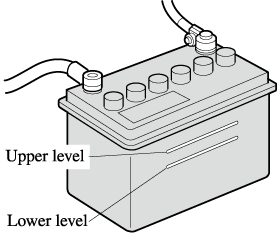Owner Maintenance Precautions
Bonnet
Engine Compartment Overview
Engine Oil
Engine Coolant
Brake/Clutch Fluid
Window and Headlight Washer Fluid
Body Lubrication
Wiper Blades
Battery
Key Battery Replacement
Tyres
Light Bulbs
Fuses
Inspecting Electrolyte Level
A low level of electrolyte fluid will cause the battery to discharge quickly.

Inspect the electrolyte level at least once a week. If it is low, remove the caps and add enough distilled water to bring the level between the upper and lower level (illustration).
Do not overfill.
Examine the specific gravity of the electrolyte with a hydrometer, especially during cold weather. If it is low, recharge the battery.


 Read this first
Read this first










